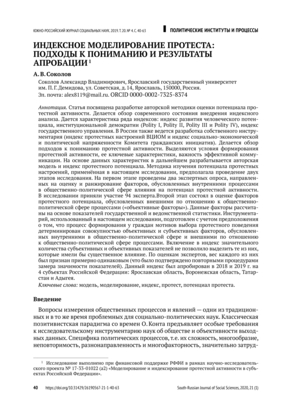Аннотация
Статья посвящена разработке авторской методики оценки потенциала протестной активности. Делается обзор современного состояния внедрения индексного анализа. Дается характеристика ряда индексов: индекс развития человеческого потенциала, институциональной демократии (Polity I, Polity II, Polity III и Polity IV), индекс государственного управления. В России также ведется разработка собственного инструментария (индекс протестных настроений ВЦИОМ и индекс социально-экономической и политической напряженности Комитета гражданских инициатив). Делается обзор подходов к пониманию протестной активности. Выделяются условия формирования протестной активности, ее ключевые характеристики, важность эффективной коммуникации. На основе данных характеристик в дальнейшем разрабатывается авторская модель и индекс протестного потенциала. Методика изучения потенциала протестных настроений, применённая в настоящем исследовании, предполагала проведение двух этапов исследования. На первом этапе проведены два экспертных опроса, направленных на оценку и ранжирование факторов, обусловленных внутренними процессами в общественно-политической сфере влияния на потенциал протестной активности. В исследовании приняли участие 94 эксперта.Второй этап состоял в оценке факторов протестного потенциала, обусловленных внешними по отношению к общественно-политической сфере процессами («объективные факторы»). Данные факторы рассчитаны на основе показателей государственной и ведомственной статистики. Инструментарий, использованный в настоящем исследовании, подготовлен с учетом предположения о том, что процесс формирования у граждан мотивов выбора протестного поведения детерминирован совокупностью объективных и субъективных факторов, обусловленных внутренними в общественно-политической сфере и внешними по отношению к общественно-политической сфере процессами. Включение в индекс значительного количества субъективных и объективных показателей не позволило выделить те из них, которые имели бы существенное влияние. По оценкам экспертов, вес каждого из них был признан примерно одинаковым (что было подтверждено повторными процедурами замера значимости показателей). Данный индекс был апробирован в 2018 и 2019 г. на 4 субъектах Российской Федерации: Ярославская область, Воронежская область, Татарстан и Адыгея.
Ключевые слова
Информация о финансировании
Исследование выполнено при финансовой поддержке РФФИ в рамках научно-исследовательского проекта № 17-33-01022 (а2) «Моделирование и индексирование протестной активности в субъектах Российской Федерации».
Библиографические ссылки
Antanovich, N.A. (2014). Indeksy kak izmeritel'nyy instrument v politologii [Indexes as a Measuring Tool in a Political Science]. Retrieved from http://elib.bsu.by/handle/123456789/94359.
Artyukhina, V. A. (2011). Sotsial'nyy protest kak proyavleniye grazhdanskogo obshchestva [Social Protest as a Manifestation of Civil Society]. Sotsiologiya v sovremennom mire: nauka, obrazovaniye, tvorchestvo [Sociology in the Modern World: Science, Education, Creativity], 3, 251–255.
Eisinger, P. K. (1973). The Conditions of Protest Behavior in American Cities. American Political Science Review,67, 11–28.
Fetisov, G. G., Oreshin, V. P. (2008). Regional'naya ekonomika i upravleniye [Regional Economics and Management]. M.: INFRA-M.
Filatova, O. G. (2014). Internet-tekhnologii politicheskoy mobilizatsii v sovremennoy Rossii [Internet Technologies in Political Mobilization of Modern Russia]. Politicheskaya ekspertiza: POLITEKS [Political Expertise: POLITEX], 10(4) 57–67.
Filinskaya, L. V., Martinkevich, A. V. (2012). Metodologicheskiye i metodicheskiye osobennosti izucheniya protestnogo potentsiala molodezhi [Methodological and Methodological Features of Studying the Protest Potential of Youth]. Zhurnal Belorusskogo gosudarstvennogo universiteta. Sotsiologiya [Journal of the Belarusian State University. Sociology], 1, 104–114.
Gamson, W.A. (1992). Talking Politics. New York: Cambridge University Press.
Gudoshnikova, O. Ye. (2015). Tekhnologii «Novykh media» kak platforma grazhdanskoy aktivnosti [New Media Technologies as a Platform for Civic Engagement]. Sovremennyye problemy nauki i obrazovaniya [Modern Problems of Science and Education], 1–1.
Heath, O. (2008). Triggers for Protest: Modelling Responses to the Political Context in Britain, 2000–2002. European Journal of Political Research, 47, 489–509.
Il'icheva, Yu. A. (2013). Mobilizatsionnyye tekhnologii: sushchnost', predposylki vozniknoveniya, osnovnyye instrumenty i sredstva [Mobilization Technologies: Essence, Background of Origin, Major Tools and Means]. Mediaskop [Mediascope], 2. Retrieved from http://www.mediascope.ru/node/1335
Le Bon, G. (2001). The Crowd: A Study of the Popular Mind. Kitchener, ONT: BatocheBooks.
Naydorf, M. I. (2010). Massovyye dvizheniya v massovykh obshchestvakh [Mass Movements in Mass Societies]. Vestnik Russkoy khristianskoy gumanitarnoy akademii [Bulletin of the Russian Christian Humanitarian Academy], 4, 220–230.
Nikiforov, A. A. (2014). Vozmozhnosti i ogranicheniya protestnoy mobilizatsii cherez sotsial'nyye seti [Opportunities and Limitations of Protest Mobilization Through Social Networks]. Pravo i politika [Law and Politics], 12, 1903–1909.
Nikovskaya, L. I. (2012). Grazhdanskoye obshchestvo i protesty: chto za nimi stoit? [Civil society and Protests: What is Behind Them?]. Monitoring obshchestvennogo mneniya: ekonomicheskiye i sotsial'nyye peremeny [Monitoring of Public Opinion: Economic and Social Changes], 4(110) 5–13.
Opp, K-D. (2012) Collective Identity, Rationality and Collective Political Action. Rationality and Society, 24(1), 73–105.
Piven, F. F., Cloward, R. A. (1991). Collective Protest: A Critique of Resource Mobilization Theory. International Journal of Politics, Culture and Society, 4(4), 435–458.
Politicheskiy atlas sovremennosti: Opyt mnogomernogo statisticheskogo analiza politicheskikh sistem sovremennykh gosudarstv [The Political Atlas of Modernity: The Experience of Multivariate Statistical Analysis of Political Systems of Modern States] (2007). M.: Izd-vo "MGIMO–Universitet".
Postill, J. (2014). Freedom Technologists and the New Protest Movements: A Theory of Protest Formulas. Convergence: The International Journal of Research into New Media Technologies, 20(4), 402–418.
Rule, J. B. (1988). Theories of Civil Violence. Berkeley, CA: University of California Press.
Sedova, N. N. (2014). Grazhdanskiy aktivizm v sovremennoy Rossii: formaty, factory, sotsial'naya baza [Civic Activism in Modern Russia: Formats, Factors, Social Base]. Sotsiologicheskiy zhurnal [Sociological Journal], 2, 48–71.
Sherstobitov, A. S. (2013). "Setevaya publichnost'" kak novyy faktor politicheskoy mobilizatsii v sovremennoy Rossii: popytka setevogo analiza [“Network Publicness” as a New Factor of Political Mobilization in Contemporary Russia: Network Analysis]. Vestnik Sankt-Peterburgskogo universiteta. Seriya 6. Filosofiya. Kul'turologiya. Politologiya. Pravo. Mezhdunarodnyye otnosheniya [Vestnik of St. Petersburg University. Series 6. Philosophy. Culturology. Political science. Right. International relationships], 3, 99–105.
Skolebina, N. A. (2010). Obshchestvennyye dvizheniya kak ob"yekt sotsiologicheskogo issledovaniya [Institutional Analysis as a Promising Direction for the Evaluation of Social Movements (An Analytical Overview)]. Vestnik Volgogradskogo gosudarstvennogo institutea [Bulletin of the Volgograd State Institute], 1(11), 51–56.
Tilly, C. (1975). Food Supply and Public Order in Modern Europe. In C. Tilly The Formation of National States in Western Europe. Princeton, NJ: Princeton University Press.
Travaglino, G. A. (2014). Social sciences and social movements: the theoretical context. Contemporary Social Science, 9(1), 1–14.
Volynchuk, A. B., Solovchenkov, S. A. (2013). Sotsial'naya napryazhennost' i protestnaya aktivnost' v kontekste analiza sotsial'noy bezopasnosti [Social Unrest and Protest Activity in The Context of The Analysis of Social Security]. Territoriya novykh vozmozhnostey. Vestnik Vladivostokskogo gosudarstvennogo universiteta ekonomiki i servisa [Territory of New Opportunities. Bulletin of the Vladivostok State University of Economics and Service], 1(19), 25–36.


